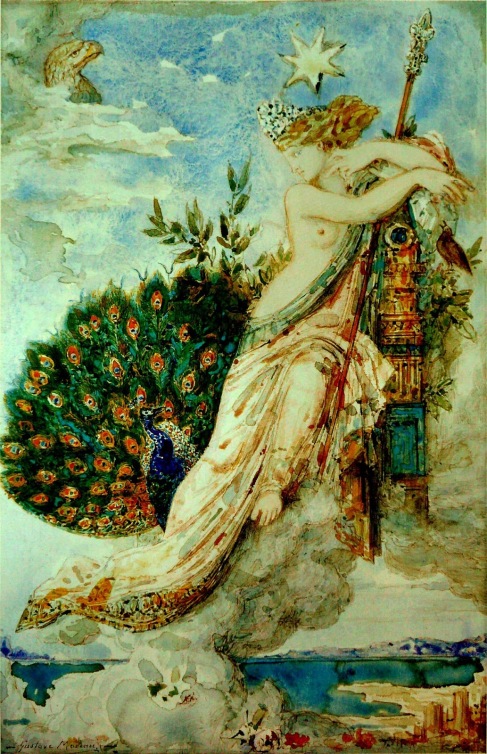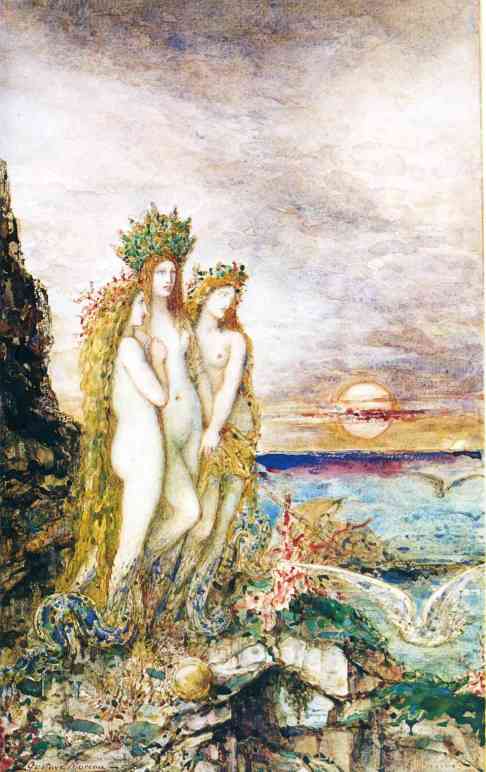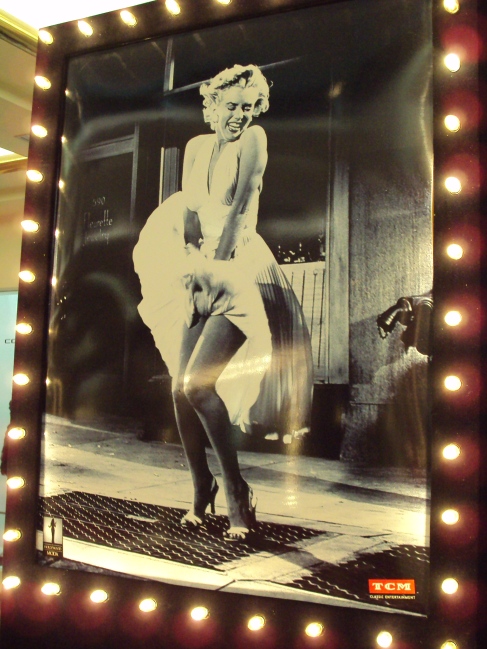Spirituality and sexuality are not your qualities, not things which ye possess and contain. But they possess and contain you; for they are powerful … manifestations of the gods, and are, therefore, things which reach beyond you, existing in themselves. No man hath a spirituality unto himself, or a sexuality unto himself. But he standeth under the law of spirituality and of sexuality.
C.G. Jung, The Seven Sermons to the Dead
Gustave Moreau’s art strikes a deep chord with me. He captures my imagination like no other painter. It was the anniversary of his birth last Sunday so I decided to share a few reflections on his art. His beloved subject were beautiful and alluring women, the ones immortalized in myth and the Bible. In his paintings they are always larger than life, terrifying and awe-inspiring, tempting, mysterious, at the same time powerful and ethereal. The mystery of the eternal feminine must have haunted him all his life. He lived with his mother until her death while his girlfriend, whom he never married, lived nearby in a flat that he was paying for. It is not my intention to interpret his birth chart here but even a quick glance at it reveals quite a lot. No less than six planets in Aries, including the Sun, the Moon (in close conjunction with Pluto) and Venus, which is squared by the rebellious Uranus. It must have been hard being him, torn between the desire for absolute freedom and all the deepest yearnings, passions and anxieties, maybe even fear of the dark feminine, which I read into his Moon in conjunction with Pluto. Carl Jung, who also had his Moon close to Pluto, wrote about his mother:
From the door to my mother’s room came a frightening influence. At night Mother was strange and mysterious. One night I saw coming from her door a faintly luminous indefinite figure whose head detached itself from the neck and floated along in front of it, in the air like a little moon.
C.G. Jung, Memories, Dreams, Relections, p. 18 (all the subsequent quotes come from the Vintage Books Edition, New York, 1965)
There is terror and mystery in these words. It also occurred to me that perhaps keeping his lover at a safe distance made it possible for Moreau to keep a divine spark in their relationship; that perhaps in this way he never ceased to see a goddess in her and was able to translate that feeling into his art. She could forever stay his anima and continue to be his divine inspiration, which was in danger of disappearing had they ever married and lived together. Here are a few Jung’s quotes on the anima, who I think is the ultimate theme of Moreau’s paintings:
…this inner feminine figure plays a typical, or archetypal, role in the unconscious of a man… (p. 186)
At first it was the negative aspect of the anima that most impressed me. I felt a little awed by her. (p. 186)
… the insinuations of the anima, the mouthpiece of the unconscious, can utterly destroy a man. (p. 187)
But the anima has a positive aspect as well. It is she who communicates the images of the unconscious to the conscious mind… For decades I always turned to the anima when I felt that my emotional behavior was disturbed, and that something had been constellated in the unconscious. I would then ask the anima: “Now what are you up to? What do you see? …” After some resistance she regularly produced an image. As soon as the image was there, the unrest or the sense of oppression vanished. The whole energy of these emotions was transformed into interest in and curiosity about the image. (p. 187)
The anima of a man has a strongly historical character. As a personification of the unconscious she goes back into prehistory, and embodies the contents of the past. She provides the individual with those elements that he ought to know about his prehistory. … In comparison to her I have always felt myself to be a barbarian who really has no history – like a creature just sprung out of nothingness, with neither a past nor a future. (p. 286)
The negative anima bewitches, seduces, is mischievous, causes delusions and makes the man neglect reality. The positive anima is the man’s guide through the unconscious; he is his Ariadna leading him out of the dark. I think Moreau captured both the negative and the positive aspect of the anima archetype. Below is a gallery of some of his images of the feminine. In Bathsheba, who became King David’s wife after he seduced her and had her then husband killed, the most extraordinary thing is the sheer size of the female figure. He covets her and feels literally small and insignificant in her presence. She looks innocent and corrupt at the same time, carrying an enormous archetypal force, since archetypes are always composed of the dark and the light side. Embracing an archetype means accepting both its creative and destructive force. Moreau was supposed to have said that he did not believe what he could touch or see, but only in what he did not see and in what he could feel. This credo gave his art the strength of the inner vision. His paintings look like dream images and have a strong otherworldly aura.
Bathsheba
Helen on the walls of Troy
Juno
Cleopatra
Desdemona
Messalina
Salome
The Sirens
We continue to be mesmerized by the power of the anima archetype when we worship female actresses, the goddesses of the cinema. Marilyn Monroe personified the anima for countless men and in the end she was consumed by that archetype, while her personality dissolved and disappeared. She became a mere collective image. This process is beautifully described in Joyce Carol Oates’ masterpiece Blonde, which is a sort of a chronicle of the inner life of Marilyn Monroe. I found the book fascinating and I particularly remember one quote:
A lush-bodied girl in the prime of her physical beauty. In an ivory georgette-crepe sundress with a halter top that gathers her breasts up in soft undulating folds of the fabric. She’s standing with bare legs apart on a New York subway grating. Her blond head is thrown rapturously back as an updraft lifts her full, flaring skirt, exposing white cotton panties. White cotton! The ivory-crepe sundress is floating and filmy as magic. The dress is magic. Without the dress the girl would be female meat, raw and exposed.
This is how a goddess was born and how the real woman died. She might have been saved had she become conscious of the danger of being swept by the collective forces. Personifying the goddess for millions of people came with a price. The essential thing, according to Jung, is to differentiate oneself from these unconscious contents and bring them into relationship with consciousness. We are not gods or goddesses but gods and goddesses act through us with a considerable amount of autonomy. They are tremendous forces and are not to be toyed with. Simone de Beavoir, the first important feminist, insisted that the notion of the eternal feminine was a myth invented by men to trap women and deny them their individuality. I believe humans will forever continue to be trapped by the seductive charms of the anima and the more we do to make this archetype conscious, the more it will enrich our lives with meaning, beauty and mystery.





















Thank you for the insightful post on a great painter. I too experience both the positive and negative aspect of the Anima. Art is a way of dealing with it. I also love Moreau’s pupil Odilon Redon, who, more than anyone, carried on Moreau’s legacy.
LikeLike
I have just googled Redon. You are right – beautiful. Thank you for the tip.
LikeLike
per usual I learned a great deal form your post. The images are awe-inspiring, Juno among my favorites. I plan to ponder the idea that the gods and goddesses embody us humans, not the other way around 🙂
LikeLike
Jung really hit the nail on the head for me with his concept of ego inflation*,* which he understood as an identification of the ego with an archetype. Archetypes such as gods and goddesses are powerful forces that act through us but once we believe we are gods ourselves we lapse into egocentricity and grandiose ideas.
LikeLike
I love Juno as well, maybe because this asteroid is conjunct my Sun. I think she combines the energies of Libra and Scorpio. Have you seen this post about asteroid goddesses? http://esotericembers.wordpress.com/?s=juno
LikeLike
thanks for the link. I have Juno conjunct Jupiter in Sag, almost conjunct my Venus in Sag. She’s pretty strong there as my Jupiter and 9th house are prominent. I would imagine Juno on your Sun would be quite influential as well. Interestingly, I have Ceres right on my Ascendant but don’t really see myself as the Earth Mother type. Maybe it will resonate down the road…..
LikeLike
Ceres is much more than the Earth Mother. She personifies the teacher and nurturer, I have her on my MC. All my knowledge of that comes once again from esotericembers.
LikeLike
hmmmmmm, I am most definitely a teacher/nurturer. I often read that she was involved with grain! I like the book Asteroid Goddesses by Demetria George. she’s mentioned in the link you sent me. I also have Chiron in my first house opp my ruler, I am not a fan of Chiron transits but the archetype of that particular asteroid is integral to my life story.
LikeLike
Reblogged this on Soul Magnitude and commented:
“The essential thing, according to Jung, is to differentiate oneself from these unconscious contents and bring them into relationship with consciousness.” (I think that truly knowing oneself is not possible without this.)
LikeLike
Thank you for reblogging this.
LikeLike
My pleasure. 🙂
LikeLike
SR, A big theme you’re adressing in this post. ‘The eternal charme of the feminine’. And then charme as well as heavenly and fatal attraction as I understand. This must sure be one of the most deep, classic and complex archetypes of all!
You say: “The negative anima bewitches, seduces, is mischievous, causes delusions and makes the man neglect reality. The positive anima is the man’s guide through the unconscious; he is his Ariadna leading him out of the dark”.
I could recognise this in the women I (try to) love and which are near to me.
But I also understand from reading about Jung that he tells us that this ‘anima’ is a part of myself as a man (at least if I don’t neglect it). This makes love and relationship maybe even more an impossible thing. I think I know now why Moreau didn’t marry ever … But as Jung states: we’re not having spirituality or sexuality but we are under the law of them.
Thanks for this post. I’ve learned a bit more about my neverending attractrion and repulsion with ‘the other sexe’ as I once already put in this haikuphoto:
http://martsart.wordpress.com/2013/01/29/shell/
LikeLike
Thanks for the insightful comment. I think I have barely touched this haunting mystery. All I do is share my fascinations. I like how you use the French word charme instead of the English charm. It is even better.
LikeLike
Les Francais savent l’amour… (et les Suisses?).
LikeLike
Mais je suis polonaise. 🙂
LikeLike
Serdecznie!
LikeLike
As with many other pointers along the Way, I am grateful for Jung, especially his attention to the psyche stretching just a tad beyond itself. But I think that he, gender bound as we all are, mistook the anima as often as he offered a revelation. I also think that we live according to Forrest Gump’s mother’s wisdom statement and its derivatives: “Stupid is as stupid does.” In other words, as long as we do not honor ourselves as the gods and goddesses that we honor then we will stay barely human. The Sirens inside us break some on the rocks of addiction and others on the shores of loneliness. Yet the addict to coffee, gambling, sex, sugar, or adrenalin all are feeling lonely and the object of their affliction is the object of their affection. The anima is simply the desire for desire, used however we do. As a woman, I am sad that it has be genderized. I am equally sad that violence has been genderized to the male gender.
Clear your article got me thinking. Good post. Thanks!
LikeLike
Wonderful words of wisdom! We absolutely must honour gods and goddesses as projections. As for Jung, he was certainly gender biased and the son of his times. Still, the way he writes is deeply inspiring for me. Thank you for making me think again!
LikeLike
Gotta love all the “pointers” on the Path of humanness. They are just as human as the rest of us!
LikeLike
I have a great link for you , one of my favorite astrologers, a master: http://www.michaellutin.com/dailyfix.htm He is incredibly on point with the personal, poilitcal, mundane, and the spiritual Let me know what you think! I have met him a few times at lectures and he is coming to Philly this summer for NCGR conference He’s up there with Robert Hand, Donna Cunningham, Buz Myers, and a few others 🙂
LikeLike
Yeah, I saw some of his stuff on the huffingtonpost and liked it!
LikeLike
Helen on the Walls of Troy is absolutely stunning. You had to know I’d come armed with music 🙂 My favorite band, hands down, and one of my top five of their songs: http://www.youtube.com/watch?v=FzXH3ZW3Wik
LikeLike
I want my readers to come armed with poetry and music. I love your recommendations, keep them coming!
LikeLike
Music for every occasion, that’s me. Lizardking teases me about it…or he did. He might not any more after I won the most expensive haircut of my life from him on a music bet: A song by an American about the fall of the British Empire. Pssht. That took me a whole 15 seconds. 🙂
LikeLike
Great post, deep stuff. Jung is a modern prophet, no doubt. I like the paintings by Moreau too – especially Helen of Troy; serenely looking out over the world, her face almost totally obscured by a pure white luminescence…
LikeLike
Thank you, beautiful comment. You do have a magical way with words.
LikeLike